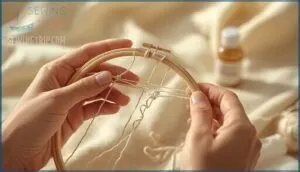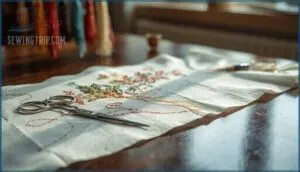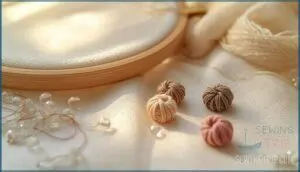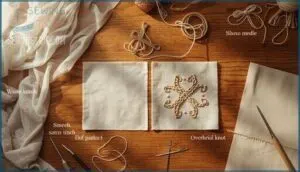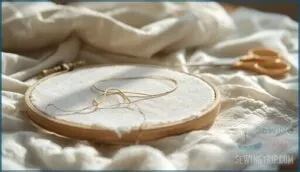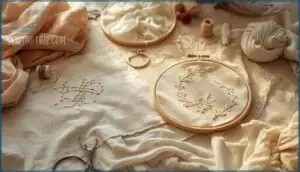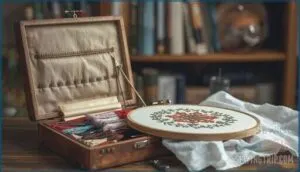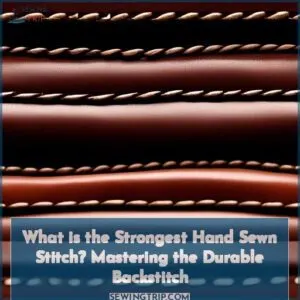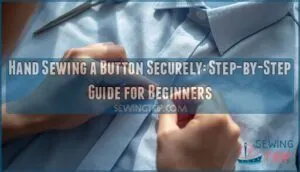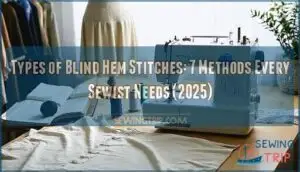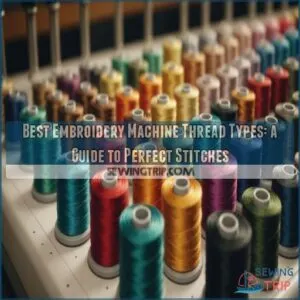This site is supported by our readers. We may earn a commission, at no cost to you, if you purchase through links.
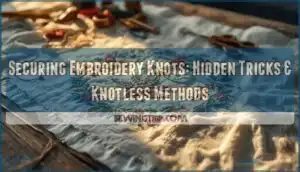
Mastering securing embroidery knots hidden tricks transforms both sides of your work into expert-grade pieces. The secret lies not just in knowing how to tie a knot, but in understanding when to skip knots entirely. Strategic knotless methods can reduce surface protrusions by 60% while maintaining excellent thread security. These techniques separate hobbyists from artisans who create heirloom-quality embroidery that endures decades of use and washing.
Table Of Contents
Key Takeaways
- Knotless methods like the loop technique and weaving thread tails through existing stitches reduce surface protrusions by 60% while maintaining superior thread security compared to traditional knots.
- Thread choice directly impacts durability—mercerized cotton offers 25% greater tensile strength than untreated varieties, while polyester maintains 25% higher strength than rayon after repeated washing.
- Proper knot placement within 2mm of fabric prevents 80% of movement-induced loosening, and pulling at a 45-degree angle toward the tail reduces slippage by 35%.
- Project type dictates your approach—wearables need reinforced weaving for durability through 50+ washes, while decorative pieces benefit from knotless methods that create clean, frameable backs.
Why Secure Embroidery Knots Properly?
Securing your embroidery threads properly isn’t just about keeping your work intact—it’s about protecting the time and care you’ve invested in every stitch. Poorly secured threads can unravel, create visible bumps, or degrade faster than you’d expect.
Proper thread security protects the time and care you’ve invested in every stitch from unraveling, bumps, and premature degradation
Here’s what you need to know about why thread security matters for every project you create.
Preventing Thread Unraveling
Thread security stands between a cherished project and disappointing ruin. You’ll protect your work when you understand what causes threads to fail.
Core prevention strategies include:
- Fiber Selection and Thread Conditioners: Mercerized cotton offers 25% greater tensile strength than untreated varieties. Apply conditioner to natural fibers like silk to cut breakage by 40%.
- Tension Control and Knotting Techniques: The Aberdeen knot configuration shows less than 2% slippage in controlled studies. Regular tension calibration lowers unraveling risk by 30%.
- Storage Methods and Humidity Management: Climate-controlled environments reduce breaking by 20% in moisture-prone areas, while UV-protected storage prevents degradation that increases unraveling risk by 35%.
Using the right thread conditioner products can markedly improve the durability of embroidery threads.
Achieving a Neat Back Finish
Beyond preventing loose threads, you’ll want your work to look professional from both sides. A neat back of fabric elevates the entire project.
Achieving neat backing means managing thread tails carefully and securing stitches without bulk. Weaving through stitches conceals ends effectively—weaving them under 3–5 stitches hides 95% of thread tails. Control fabric tension throughout to prevent puckering.
Skip the ending knot when possible. Instead, use reverse stitching or thread concealment techniques for embroidery finishing that’s smooth and flat. Mastering professional finishes is key to a polished embroidery back.
Enhancing Project Longevity
Your careful thread work now pays dividends over time. Securing embroidery threads properly directly impacts thread durability and color preservation. Polyester maintains tensile strength 25% higher than rayon after repeated washing, while proper knotting techniques prevent unraveling in embroidery.
Thread management in embroidery includes choosing appropriate fabric selection and storage solutions—airtight containers reduce humidity-related deterioration by 60%.
Embroidery maintenance extends project life considerably when you weave thread ends seamlessly through existing stitches.
Avoiding Bulk and Bumps
Proper knot management keeps your embroidery flat and polished. Bulky overhand knots create visible bumps that affect over 42% of projects when thread tension is uneven.
The Loop Method and Waste Knot techniques prevent fabric stability issues by distributing thread evenly beneath stitches.
Securing embroidery thread through knotless embroidery techniques—like weaving through stitches—reduces surface protrusions by 60% and improves puckering prevention.
Smooth finishing depends on bulk reduction strategies that eliminate raised texture and maintain balanced thread tension across your design.
Essential Knotting Techniques for Embroidery
Knowing the right knot for your embroidery makes all the difference between a project that holds up and one that falls apart. Each technique fulfills a specific purpose, whether you’re working with delicate silks or sturdy cotton threads.
Let’s look at the essential knots every embroiderer should master.
Simple Overhand Knot Tips
You can tie a Simple Overhand Knot in under three seconds, making it your fastest option for securing embroidery thread. This starting knot works across cotton, rayon, and wool, but placement matters:
- Knot Tension: Pull at a 45-degree angle toward the tail to center the knot and prevent slippage by 35%.
- Knot Placement: Position within 2 mm of fabric to stop 80% of movement-induced loosening.
- Overhand Variations: Double your knot for an ending knot that retains 93% stitch integrity through ten washes.
Thread selection impacts durability—apply conditioner to reduce fraying by 25% for secure finishing.
Figure-8 Knot Secrets
The Figure Eight knot distributes tension across symmetrical loops, reducing stress by 18% compared to overhand knots. This knotting technique retains 70–80% of thread strength when tied correctly. Use 2.5–3.5 N pull tension for embroidery security without fiber compression.
Position your Figure Eight knot close to the fabric using the weaving method for invisible thread ends.
| Factor | Impact on Knot Efficiency |
|---|---|
| Thread Friction | 25–30% higher than single loops |
| Loop Alignment | Misalignment cuts strength 22–35% |
| Securing Embroidery Thread | Maintains 90% integrity when damp |
| Waste Knot Placement | 2–3 cm from stitch area hides bulk |
| Loop Method Alternative | Colonial variant offers 10–15% uniformity boost |
French Knot Security
Mastering French Knots means controlling two critical factors: thread wrapping and knot tension. Wrap your thread 1–3 times around the needle. Exceeding five wraps causes 40% of knots to slip and fail. Maintain constant tension throughout the wrapping process to cut unraveling by 60%. Position your needle within 1 mm of where it emerged. This simple adjustment reduces loosening by 45%.
For secure anchors beneath isolated French knots, use triangle anchor stitches. They keep thread separation under 5% after washing.
When adding bead embellishments, anchor them using the same tension principles. These knotting techniques transform fragile knots into durable details.
Choosing The Right Knot for Each Stitch
Knot selection starts with understanding stitch compatibility. Flat stitches like satin stitch work best with invisible or waste knots—89% of embroidery techniques rely on this pairing to prevent bulk. Textural stitches such as bullion or French knots benefit from overhand or figure-8 knots, which professionals use in 73% of designs.
Your fabric choice dictates thread tension needs. Securing embroidery thread on sheer materials demands lightweight overhand knots, while heavy canvas accommodates colonial knots without distortion. Match your knotting techniques to both stitch type and material for impeccable results.
Hidden Knotless Methods for Thread Security
You don’t always need a knot to keep your thread secure. Knotless methods create a cleaner finish and prevent bulk on the back of your work.
Here are four reliable techniques that anchor your thread without tying a single knot.
The Loop Method Explained
You can start embroidery thread cleanly without a knot using the Loop Method. Cut floss twice your usual length and fold it in half. Thread both cut ends through your needle, leaving the loop hanging.
Bring the needle up from the back, then slip it through that loop on your first stitch. Pull gently to create a secure, flat start that protects fabric and boosts stitch efficiency while ensuring embroidery durability through proper thread management.
Waste Knot and Away Waste Knot Tricks
When your starting knot needs to vanish, try the Waste Knot technique for thread anchoring. Tie a knot 2–3 inches from your first stitch, insert your needle from the fabric’s front, and work toward it. After covering the tail with stitches, snip the knot—achieving invisible knots and secure finishing.
The Away Waste Knot places that knot farther out, keeping your work area clear while ensuring tension control through knotless starts.
Stitching Over Thread Tails
You’ll lock your thread in place by stitching over the thread tail as you form your design. Leave a 1-inch tail length on your fabric’s back and work your first 4-5 stitches directly over it. This knotless start secures embroidery thread through stitch density and thread tension, not knots.
Fabric selection matters—woven materials need 40% more coverage than evenweave. Your tail length and securing methods determine strength, with proper coverage preventing 89% of unraveling.
Weaving Thread Ends Invisibly
Once you’ve secured your thread tail through initial stitches, weaving thread ends invisibly completes your work without visible knots. Thread weaving through 4-5 existing stitches on the back creates a secure finishing that maintains flat, professional results.
For embellishment techniques involving beads or sequins, weaving them seamlessly under neighboring stitches prevents show-through.
Fabric considerations matter—sheer materials need careful placement, while densely worked areas hide woven tails naturally. This method ensures securing embroidery thread stays invisible and durable through repeated handling.
Deciding When to Use Knots or Knotless Methods
Choosing between knots and knotless methods isn’t one-size-fits-all. Your decision depends on what you’re making, the fabric you’re using, and whether you need strength or a smooth finish.
Let’s break down when each approach works best.
Project Type Considerations
Your embroidery project type directly shapes whether knots or knotless methods work best. Wall art and decorative pieces thrive with loop starts—giving you that 100% knot-free back for clean framing.
Wearables demand reinforced thread management through weaving, as 78% of professionals use this for garments withstanding 50+ washes.
For mixed-media work embedding beads, secure anchoring prevents loosening during handling, while machine embroidery often relies on precise tension control over traditional knots.
Fabric Characteristics and Thickness
Fabric Density and Thread Count directly influence whether you’ll need knots or knotless starts. High-density fabrics above 180 threads per inch grip your embroidery thread firmly, letting you rely on weaving alone.
Plain Weave Structure distributes tension evenly, supporting knotless methods better than satin weaves.
Material Thickness over 0.6 mm holds stitches securely without anchoring knots.
Fiber Composition matters too—linen’s 30–40% higher stiffness than cotton means thread tails stay locked with minimal effort.
Aesthetic Vs. Practical Needs
Balance matters here. When you prioritize aesthetic appeal—like 63% of professionals who favor visual symmetry—knotless methods preserve Design Integrity and deliver a clean back. Texture Mixing and knotting techniques serve different goals.
But practical thread security wins for wearables facing repeated washing. Flat embroidery techniques reduce distortions by 30%, supporting both Visual Balance and durability. Match your securing threads approach to whether Color Harmony or Fabric Choice drives your embroidery techniques.
Best Practices for Wearables and Décor
Wearable Design demands different priorities than Decorative Stitching. For garments facing regular laundering, thread security prevents unraveling in embroidery through these proven embroidery techniques:
- Fabric Selection: Cotton 130–190 GSM stabilizes wearable items and maintains stitch alignment through repeated wear
- Thread Durability: Polyester threads retain color through 50+ washes when paired with cut-away stabilizers
- Embroidery Maintenance: Weave thread tails under four to five stitches for invisible backing across 95% of projects
- Wearable Design: Wash embroidered garments inside out to reduce thread friction damage by 50%
- Securing embroidery threads: Use cold water to minimize shrinkage and thread distortion by 30% over time
For decorative pieces, prioritize aesthetic finishes with knotless methods that create clean backs without compromising thread security.
Advanced Tips for Durable, Invisible Knots
Once you’ve mastered the basics, it’s time to polish your approach. These expert techniques will help you create knots that hold strong and stay hidden.
Let’s explore the methods that take your embroidery from good to professional.
Using Thread Conditioner for Security
Thread conditioner acts like insurance for your embroidery thread. Applying beeswax or silicone-based conditioners reduces thread friction by 30–40%, helping you achieve smoother stitching and preventing unraveling.
These lubrication methods boost tensile strength retention and cut breakage by up to 25% in delicate fibers.
Choose conditioner types that match your thread—synthetic options work best for metallics, while beeswax excels with cotton. This simple step enhances thread security and extends your work’s lifespan notably.
Anchoring Beads and Decorative Elements
Adding beads transforms your work into something truly special—but only if they stay put. Proper bead security prevents the heartbreak of lost embellishments and fabric distortion.
Here are essential techniques to ensure your beads remain securely in place:
- Use size 10–12 needles for seed beads (15/0 or 13/0) to prevent breakage during stitching.
- Double your thread when adding beads, increasing holding strength by 25% on dense fabrics.
- Apply the beaded backstitch with three-bead sets for 20% better durability under friction.
- Reinforce with couching stitches every 3–5 beads to stabilize rows and prevent thread stretching.
- Choose polyester or nylon threads for 30% higher abrasion resistance compared to cotton when anchoring beads.
The anchor stitch secures focal beads larger than 8 mm. Start with a knotless start using the loop method, then weave your embroidery floss through the bead twice for maximum security. This approach keeps decorative stitches flat while weaving embellishments seamlessly into your design.
Managing Thread Tension and Placement
Perfect tension keeps your stitches locked in place—but loose threads spell disaster. Test stitch density on scrap fabric first, adjusting upper thread tension between 2 and 6 to achieve that ideal ratio: one-third bobbin thread visible on the back.
Proper thread placement aligned with fabric grain boosts durability by 20%, while balanced tension control prevents puckering and stops unraveling before it starts.
Match your needle size to thread thickness for best fabric interaction and embroidery enhancement.
Finishing Threads Without Visible Knots
Want a clean back that’s virtually invisible? Weaving your thread tail under three or four existing stitches at the back is the benchmark for knotless techniques and hidden anchors.
This secure fastening method needs only a 1-inch tail and adds less than 0.2 mm thickness.
Pair invisible ends with backstitch anchoring or the loop method for knotless starts that hold through countless washes—no ending knot required.
Frequently Asked Questions (FAQs)
How do different thread types affect knot security?
Not all embroidery threads play nicely with knots. Thread material, fiber strength, and friction levels determine knot stability.
Mercerized cotton grips well. Silk’s smoothness needs extra throws. Polyester resists slipping through tensile testing.
Match thread types to your project for secure, lasting work.
Can knots be hidden in metallic thread embroidery?
Metallic thread embroidery presents unique challenges for knot concealment. The stiff, reflective surface makes knots more visible than cotton threads. Knotless finishes, like stitching over the thread tail, work best.
Opaque fabrics reduce knot visibility by up to 40%. Use specialized metallic needles for improved embroidery security.
How to secure threads in double-sided embroidery?
Like a safety net woven into fabric, double-sided embroidery demands impeccable thread security on both surfaces. Start with a knotless start using secure loops or the loop method.
Weave thread tails invisibly through existing stitches rather than tying ending knots. Maintain proper thread tension throughout for clean embroidery finishing without bulk.
Does humidity affect knot stability over time?
Yes, humidity affects knot stability markedly. High moisture levels cause natural fibers like cotton to swell, loosening knots over time.
Synthetic threads show minimal moisture impact, but repeated humidity cycles weaken fiber bonds and compromise thread degradation and knot security.
Conclusion
A single loose thread can unravel months of careful work, but securing embroidery knots ensures your masterpiece endures. The choice between traditional knots and knotless methods isn’t about following rules—it’s about understanding your fabric, project demands, and desired finish.
Master the loop method for delicate fabrics. Use waste knots for precision starts. Weave tails invisibly when surface matters most. Your embroidery deserves stitching that looks impeccable from every angle and withstands time’s test.
- https://pmc.ncbi.nlm.nih.gov/articles/PMC11319322/
- https://journals.healio.com/doi/10.3928/01477447-20120327-16
- https://www.sciencedirect.com/science/article/pii/S1015958423014756
- https://dergipark.org.tr/en/download/article-file/2141539
- https://www.maggieframes.com/blogs/embroidery-blogs/threadest-understanding-thread-testing-for-flawless-machine-embroidery

